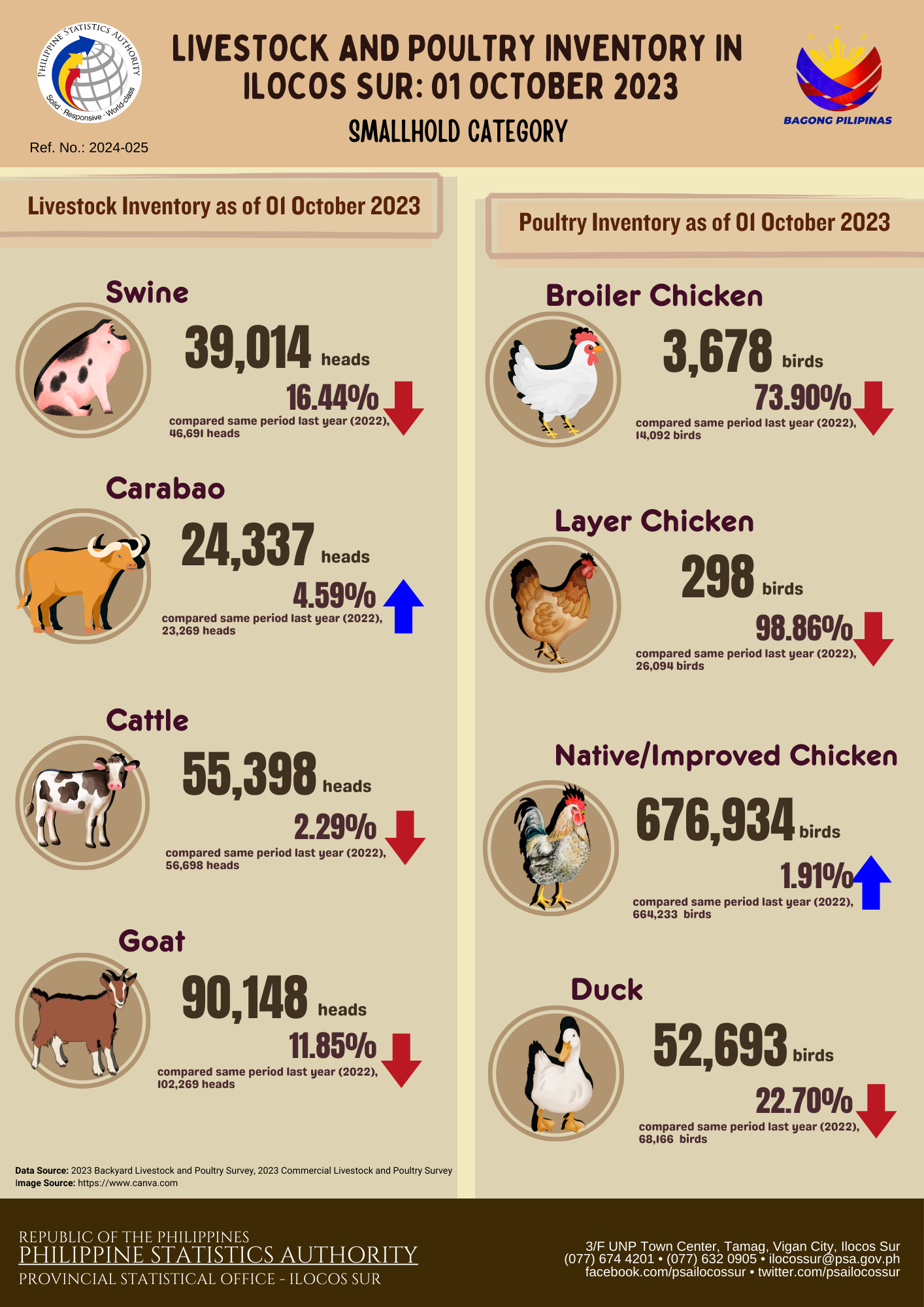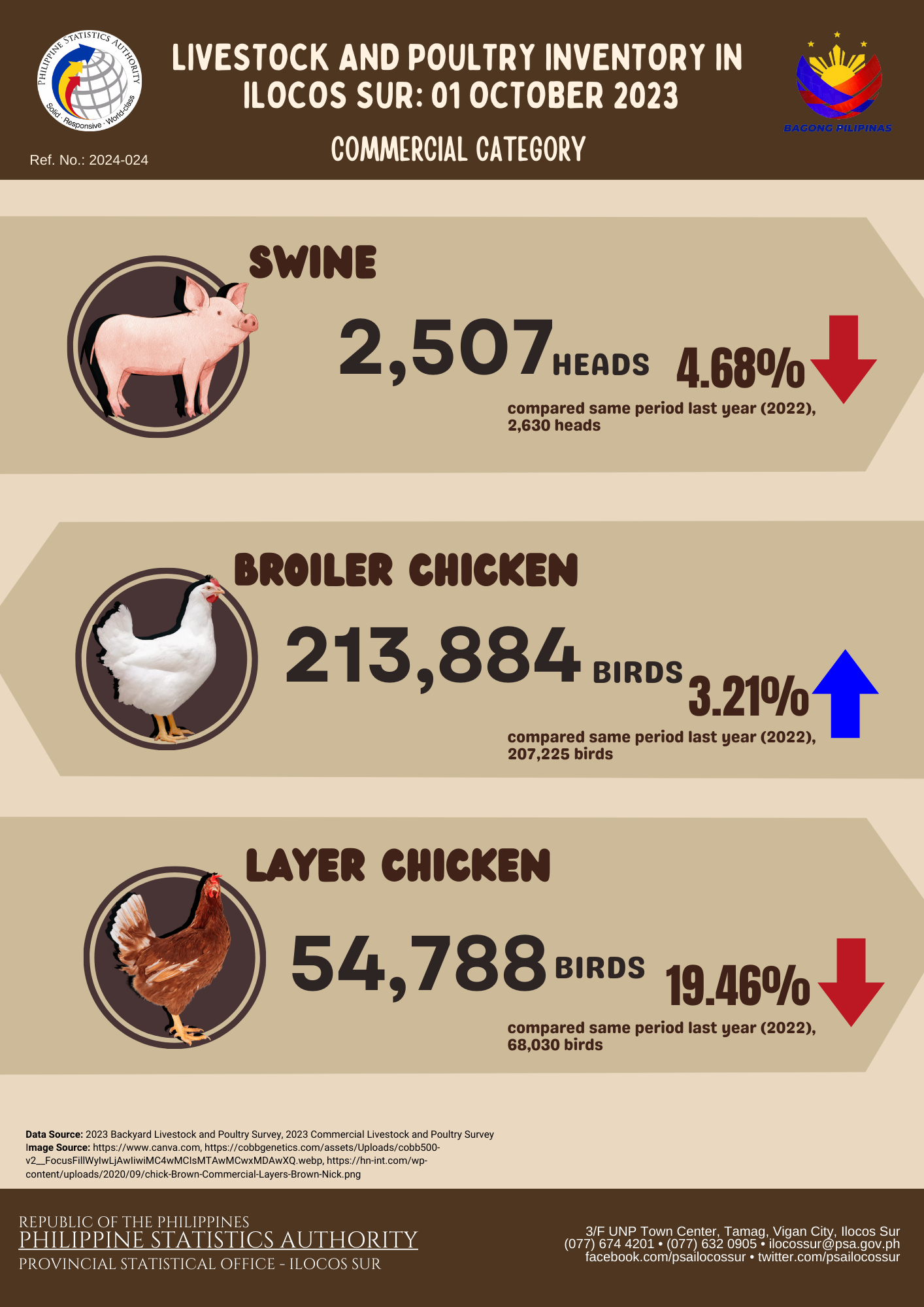The total Livestock and Poultry inventory in Pangasinan stood at 7,019,235 heads as of July 1, 2023. This reflects a 44.0 percent increase compared to the inventory recorded for the same period in the previous year, which was reported to be 4,873,358 heads. (Table 1).
The Livestock inventory went up by 8.3 percent, representing an increase from 326,285 heads in the second quarter of 2022 to 353,524 heads in the same period in 2023. Carabao, and Cattle inventory decreased by 18.7 percent, and 11.8 percent, respectively, while Swine and Goat grew by 51.8 percent, and 0.2 percent, respectively.
Table 1. Livestock and Poultry Inventory by Animal Type,
Pangasinan: Second Quarter 2022-2023
Source: Philippine Statistics Authority
On the other hand, Poultry inventory went up by 46.6 percent, reflecting an increase from 4,547,073 heads in the second quarter of 2022 to 6,665,711 heads for the same period in 2023. The total Poultry inventory comprises of Chicken which was higher by 48.6 percent and Duck which declined by 29.1 percent in the second quarter of 2023. (Table 1)
Figure 1. Percent Distribution of Livestock Inventory by Animal Type,
Pangasinan: Second Quarter 2023
Source: Philippine Statistics Authority
The Livestock sector, which comprises Carabao, Cattle, Goat, and Swine, reported a total count of 353,524 heads. Swine has the highest contribution to the total Livestock inventory, with 37.1 percent share equivalent to 130,995 heads, followed by the inventory of Goat with 33.8 percent share, amounting to 119,344 heads. Meanwhile, Cattle and Carabao accounted for 17.9 percent and 11.3 percent, with estimates of 63,402 heads and 39,783 heads, respectively. (Figure 1 and Table 1).
In terms of the Poultry sector, Chicken inventory with 6,580,766 heads recorded in the second quarter of 2023 surpassed the Duck inventory of 84,945 heads. The total Chicken inventory comprises Broiler, Layer, and Native/Improved. Broiler accounted for 64.4 percent of the total count of Chicken with 4,235,880 heads; Native/Improved shared 32.2 percent or 2,115,753 heads, while Layers contributed the least with 3.5 percent, or equivalently 229,133 heads. (Figure 2 and Table 1).
Figure 2. Percent Distribution of Poultry Inventory by Animal Type,
Pangasinan: Second Quarter 2023
Source: Philippine Statistics Authority
In terms of Livestock slaughtered in slaughterhouses and Chicken dressed in dressing plants in Pangasinan for the second quarter of 2023, a total of 1,401,060 heads were recorded. This reflects a 60.4 percent decline compared to the total count of slaughtered/dressed for the same period in the preceding year estimated at 3,534,143 heads. (Table 2).
Livestock slaughtered in slaughterhouses went up by 4.4 percent, from 71,818 heads to 74,987 heads. Meanwhile, Chicken dressed in dressing plants in the province during the said period were estimated at 1,326,073 birds, a 61.7 percent decline from 3,462,325 birds recorded in the previous year.
Table 2. Slaughtered/Dressed by Type,
Pangasinan: Second Quarter 2022-2023 
Source: Philippine Statistics Authority
In the second quarter of 2023, the number of Hogs slaughtered in slaughterhouses saw an increase of 7.8 percent, rising from 62,550 heads in 2022 to 67,439 heads. Conversely, slaughtered Cattle and Carabao experienced a 23.1 percent and 12.3 percent decreases, estimated at 4,380 and 3,125 heads, respectively. Meanwhile, there were 43 slaughtered goats recorded in the said period. (Table 2).
Figure 3. Percent Distribution of Livestock Slaughtered In Slaughterhouses,
Pangasinan: First Quarter 2023
Of the 74,987 Livestock slaughtered in slaughterhouses in 2023, 89.9 percent was Hog, 5.8 percent was Cattle, 4.2 percent was Carabao, and 0.1 percent was Goat. (Figure 3).
EDGAR M. NORBERTE
Chief Statistical Specialist
Provincial Statistical Office - Pangasinan
TECHNICAL NOTES
The Livestock and Poultry Performance Report presents an overview of the performance trends in terms of inventory for carabao, cattle, goat, swine, and various types of chickens, along with the volume of production, including chicken eggs. The data for this special release were meticulously gathered by the Philippine Statistics Authority (PSA) through two primary surveys: (1) The Backyard Livestock and Poultry Survey (BLPS), conducted on a quarterly basis, covers a comprehensive sample size of 280 households. This survey serves to capture the dynamics of livestock and poultry inventory at the household level; (2) The Commercial Livestock and Poultry Survey (CLPS), also administered quarterly, encompasses a broader scope. It involves data collection from various sectors, including 1 carabao farm, 12 cattle farms, 12 goat farms, 6 swine farms, 4 native chicken farms, 11 layer farms, and 16 broiler commercial farms and contract growers, all as of July 1, 2023.
Another survey that supplements the data requirements of the Livestock and Poultry sector is the Compilation of Data Slaughterhouses and Poultry Dressing Plants (CDSPDP). This is done monthly and utilizes administrative data from Locally Registered Meat Establishments (LRMEs) in the province which is in coordination with the Provincial Veterinary Office (PVO) and Meat Inspectors (MIs).
•Livestock – farm animals kept or raised for consumption, work or leisure. In general, poultry is separated as a distinct group of farm animals. For purposes of census and surveys, livestock covers only those that are tended and raised by an operator.
•Poultry – a collective term for all domesticated avian for the purpose of food consumption or, the carcass of such avian dressed/processed for human consumption.
•Animal Inventory (also, Animal Population) – the number of domesticated animals in head present in the farm at specific reference date.
•Dressing – the progressive separation on the dressing floor of food animal into carcass, offal and inedible by-products.
•Slaughter – refers to butchering of animal for the purpose of human consumption.
•Slaughterhouse/Dressing Plant – the premises that are approved and registered by a controlling authority in which food animals/birds are slaughtered and dressed for human consumption.




